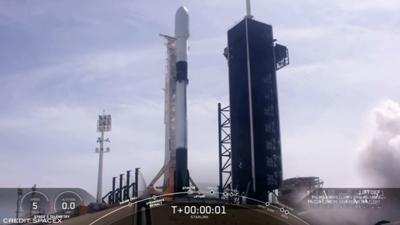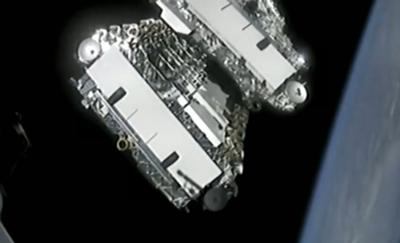Tue, Aug 18, 2020
Booster Will Be Flown (And Hopefully Recovered) For SIXTH Time
SpaceX is targeting Tuesday, August 18 at 10:31 a.m. EDT for launch of its eleventh Starlink mission, which will include 58 Starlink satellites and three of Planet's SkySats.

Falcon 9 will lift off from Space Launch Complex 40 (SLC-40) at Cape Canaveral Air Force Station in Florida. Falcon 9’s first stage previously supported the Telstar 18 VANTAGE mission in September 2018, the Iridium-8 mission in January 2019, and three separate Starlink missions in May 2019, January 2020, and June 2020.
Following stage separation, SpaceX will land Falcon 9’s first stage on the “Of Course I Still Love You” droneship, which will be stationed in the Atlantic Ocean. Falcon 9’s fairing previously flew on the fourth launch of Starlink. Planet’s SkySats will deploy sequentially beginning about 12 and a half minutes after liftoff, and the Starlink satellites will deploy approximately 46 minutes after liftoff.
This will reportedly be SpaceX’s 99th mission (and 92nd use of a Falcon 9) and the booster being used will hopefully be the first booster to have successfully launched and landed 6 times!!!

With performance that is expected to surpass that of traditional satellite internet, and a global network unbounded by ground infrastructure limitations, Starlink may soon deliver high speed broadband internet to locations where access has been unreliable, expensive, or completely unavailable. Starlink is targeting service in the Northern US and Canada in 2020, rapidly expanding to near global coverage of the populated world by 2021.
Starlink is also claiming to be on the leading edge of on-orbit debris mitigation, meeting or exceeding all regulatory and industry standards. At end of life, the satellites will utilize their on-board propulsion system to deorbit over the course of a few months. In the unlikely event the propulsion system becomes inoperable, the satellites will burn up in Earth’s atmosphere within 1-5 years, significantly less than the hundreds or thousands of years required at higher altitudes.
More News
Aero Linx: JAARS Nearly 1.5 billion people, using more than 5,500 languages, do not have a full Bible in their first language. Many of these people live in the most remote parts of>[...]
'Airplane Bounced Twice On The Grass Runway, Resulting In The Nose Wheel Separating From The Airplane...' Analysis: The pilot reported, “upon touchdown, the plane jumped back>[...]
"Burt is best known to the public for his historic designs of SpaceShipOne, Voyager, and GlobalFlyer, but for EAA members and aviation aficionados, his unique concepts began more t>[...]
"Polaris Dawn, the first of the program’s three human spaceflight missions, is targeted to launch to orbit no earlier than summer 2024. During the five-day mission, the crew >[...]
There Are SO Many Ways To Get YOUR Aero-News! It’s been a while since we have reminded everyone about all the ways we offer your daily dose of aviation news on-the-go...so he>[...]
 ANN's Daily Aero-Linx (05.04.24)
ANN's Daily Aero-Linx (05.04.24) NTSB Final Report: Quest Aircraft Co Inc Kodiak 100
NTSB Final Report: Quest Aircraft Co Inc Kodiak 100 Aero-News: Quote of the Day (05.04.24)
Aero-News: Quote of the Day (05.04.24) Aero-News: Quote of the Day (05.05.24)
Aero-News: Quote of the Day (05.05.24) Read/Watch/Listen... ANN Does It All
Read/Watch/Listen... ANN Does It All




